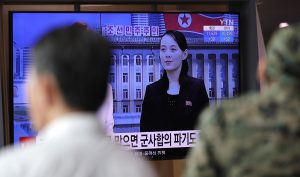Late last month, North Korean leader Kim Jong Un presided over a preliminary meeting of the Central Military Commission of the Workers’ Party of Korea (WPK), which was held in the unusual form of a video conference. The meeting announced that military operations planned against South Korea, proposed by the General Staff Department of the Korean People’s Army, had been “suspended.” Although it is not clear what kind of image Pyongyang wanted to present, the revelation appeared to showcase Kim as the gamechanger.
The proximate cause of this whiff of gunpowder on the Korean Peninsula was a statement issued on June 4 by Kim Yo Jong, the First Vice Director of the WPK, which heavily criticized both a leaflet drop across the border conducted by groups of North Korean defectors, along with the South Korean government, which has given tacit approval to such acts. Kim, who is the sister of Kim Jong Un, even suggested “the worst outcome” would ensue. After making that prediction on June 13, the inter-Korean joint liaison office, the symbol of North-South Korea reconciliation, was detonated.
This dramatic turn of events was clearly driven by irritation and anger at the non-performance of the agreement between North and South Korea and at the Pyongyang-Washington stalemate. A desire to unite the people of North Korea amid a struggling economy may have been an additional factor. The recent developments also offer some insights that help us understand news reports about North Korea.
What is key whenever North Korea presents news to the outside world is who is introducing the news. So what was noteworthy with this recent news is the fact that Kim Jong Un kept his silence until June 23. While his sister took on the hardline role, Kim himself made no mention at all of the North-South relationship, not even at the meeting of the Political Bureau of Workers’ Party of Korea that he hosted on June 7.
Although it is well known that North Korea has a centralized administration framework under one supreme leader, it is easy to get distracted by hardline language. Kim Yo Jong is well known in South Korea, and the announcement that she had issued an order regarding policy toward South Korea helped Pyongyang generate a significant impact on the government and people of South Korea.
News reports about Kim Jong Un’s movements and statements are published on the front page of the Rodong Sinmun newspaper, which underscores their absolute significance inside North Korea. However, all of Kim Yo Jong’s remarks were published on the second page. Although his sister has emerged as an assistant and spokesperson for Kim Jong Un, she does not receive the same treatment. In contrast to her brother, her name and statements are not published in bold letters. Her name does not bear the honorific titles, such as “Supreme Leader” or “the Dear Respected Comrade,” which are accorded her brother. No exalted terms that are unique to the Korean and Japanese language have been used for her in news reports.
The second point is how she is depicted in news reports. North Korea released a series of comments in which it condemned the United States last fall. However, the comments were messages only to other countries through Korean Central News Agency and were not published in the Rodong Sinmun. In other words, they were never announced to the people in North Korea. The two comments released by Kim Yo Jong in March this year were treated in the same manner.
Since the beginning of June, however, a series of statements from Kim Yo Jong, in which she predicted a worsening North-South relationship, were published in the Rodong Sinmun. Immediately after her comment was released on June 4, a nationwide campaign in support began, claiming that “retaliatory punishment against the south” had become a national consensus. For this reason, it appeared highly likely that the plan to blow up the liaison office was no mere threat.
However, there still is no criticism of President Moon Jae-in by name, only criticism of the “President” or “Head of State” of South Korea. This means that there is some room to walk back the hardline approach.
The third point is the need to discern if a threat posed is specific and realistic. A specific warning was given regarding the blast this time by Kim Yo Jong and the implementation of the plan was highly probable because it posed no risk to life.
Unlike the bombardment of Yeonpyeong Island in November 2010, the fact that North Korea implemented its policy after having issued a warning first suggests that the country made a final decision only after observing the reactions of South Korea.
In August 2017, North Korea made an announcement in the form of a personal comment saying “it is seriously considering a plan that could see it fire four missiles near the U.S. territory of Guam.” Implementing that plan would have been suicidal. So it is worth nothing the use of the ambiguous expression “consider” and the fact that the comment was not made by Kim Jong Un himself.
On the day after demolishing the joint liaison office, Kim Yo Jong issued another statement, saying only that South Korea will “pay a high price.” No specific prediction was made. The General Staff Department of the Korean People’s Army, responsible for military planning, also commented that any plan would be subject to the approval of the Central Military Commission. Needless to say, the Commission is led by Kim Jong Un.
Atsuhito Isozaki is an associate professor at Keio University.

































